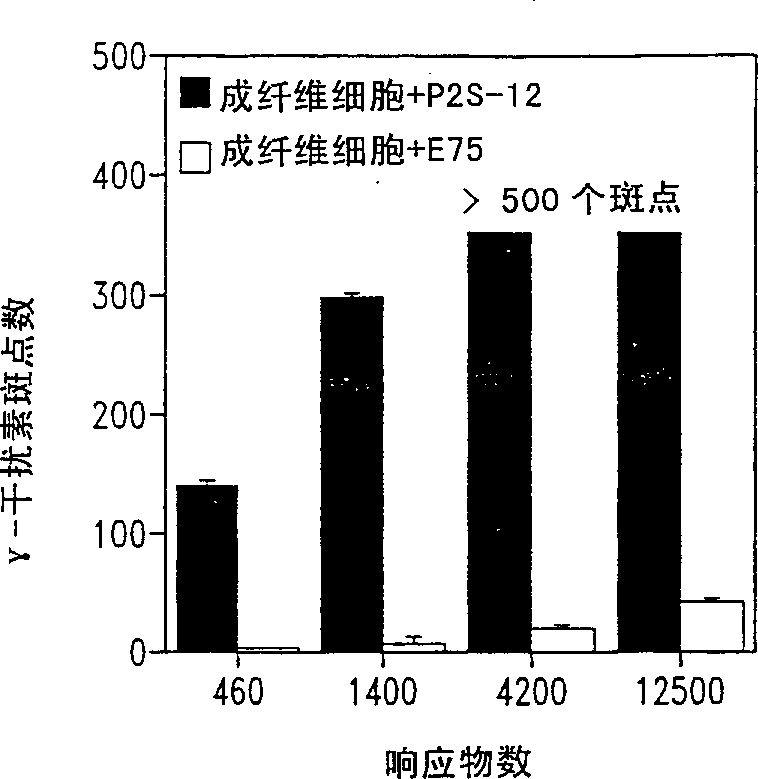Compositions and methods for therapy and diagnosis of prostate cancer
A prostate tumor and sequence technology, applied in the fields of botanical equipment and methods, biochemical equipment and methods, chemical instruments and methods, etc., can solve the problems of difficult and effective diagnosis and treatment of prostate cancer, and does not show the level of metastasis
- Summary
- Abstract
- Description
- Claims
- Application Information
AI Technical Summary
Problems solved by technology
Method used
Image
Examples
Embodiment 1
[0580] Isolation and Characterization of Prostate Tumor Peptides
[0581] This example describes the isolation of certain prostate tumor polypeptides from a prostate tumor cDNA library.
[0582] A human prostate tumor cDNA expression library was constructed from prostate tumor polyA+ RNA using the Superscript plasmid system for cDNA synthesis and plasmid cloning kit (BRLLife Technologies, Gaithersburg, MD 20897) according to the manufacturer's recommended method. Specifically, prostate tumor tissue was homogenized with polytron (Kinematica, Switzerland), and total RNA was extracted with Trizol reagent (BRL Life Technologies) according to the manufacturer's instructions. Then, poly A+ RNA was purified using Qiagen oligotex spin column mRNA purification kit (Qiagen, Santa Clarita, CA 91355) according to the manufacturer's recommended method. First-strand cDNA was synthesized with Not I / Oligo-dT18 primer. Double-stranded cDNA was synthesized, ligated with EcoRI / Ba...
Embodiment 2
[0601] Determination of tissue specificity of prostate tumor polypeptide
[0602] Using gene-specific primers, reverse transcription PCR was used to detect representative prostate tumor polypeptides F1-16, H1-1, J1-17 (also known as P502S), L1-12 (also known as P501S) in a variety of normal and tumor tissues. ), F1-12 (also known as P504S) and N1-1862 (also known as P503S) mRNA expression levels.
[0603] Briefly, total RNA was extracted from a variety of normal and tumor tissues using Trizol reagent as described above. 1-2 μg of total RNA was taken, and the first strand was synthesized at 42° C. for 1 hour using SuperScript II reverse transcriptase (BRL Life Technologies). The cDNA is then amplified by PCR using gene-specific primers. To ensure the semi-quantitative nature of reverse transcription PCR, β-actin was used as an internal control for each tissue tested. First, serial dilutions of first-strand cDNA were prepared for reverse transcription PCR detection ...
Embodiment 3
[0615] Isolation and identification of prostate tumor polypeptides by PCR-based subtraction
[0616] The cDNA subtraction library was purchased from Clontech, which contained 10 other normal tissue cDNAs (brain, heart, kidney, liver, lung, ovary, placenta, skeletal muscle, spleen and thymus) for subtraction, followed by the first Normal prostate cDNA amplified by rounds of PCR. This library was subjected to a second round of PCR amplification according to the manufacturer's recommended method. The resulting cDNA fragment was subcloned into the vector pT7 Blue T-vector (Novagen, Madison, WI) and transformed into XL-1 Blue MRF' E. coli (Stratagene). DNA was isolated from independent clones and sequenced using a Perkin Elmer / Applied Biosystems Division Automated Sequencer Model 373A.
[0617] 59 positive clones were sequenced. Comparing the DNA sequences of these clones with those in the above-mentioned gene bank showed no obvious homology with 25 of the clones, namely P5...
PUM
 Login to View More
Login to View More Abstract
Description
Claims
Application Information
 Login to View More
Login to View More - R&D
- Intellectual Property
- Life Sciences
- Materials
- Tech Scout
- Unparalleled Data Quality
- Higher Quality Content
- 60% Fewer Hallucinations
Browse by: Latest US Patents, China's latest patents, Technical Efficacy Thesaurus, Application Domain, Technology Topic, Popular Technical Reports.
© 2025 PatSnap. All rights reserved.Legal|Privacy policy|Modern Slavery Act Transparency Statement|Sitemap|About US| Contact US: help@patsnap.com



